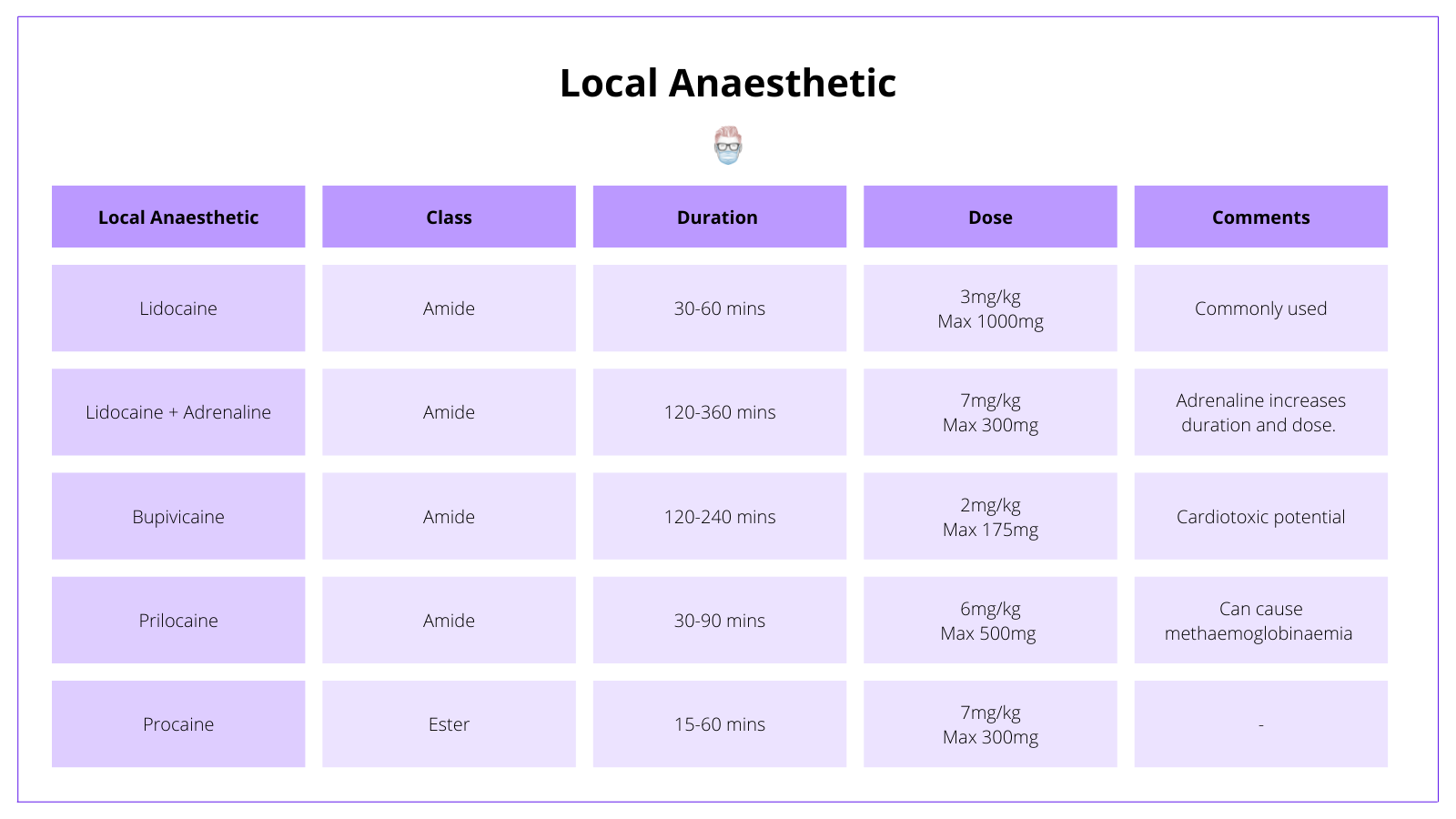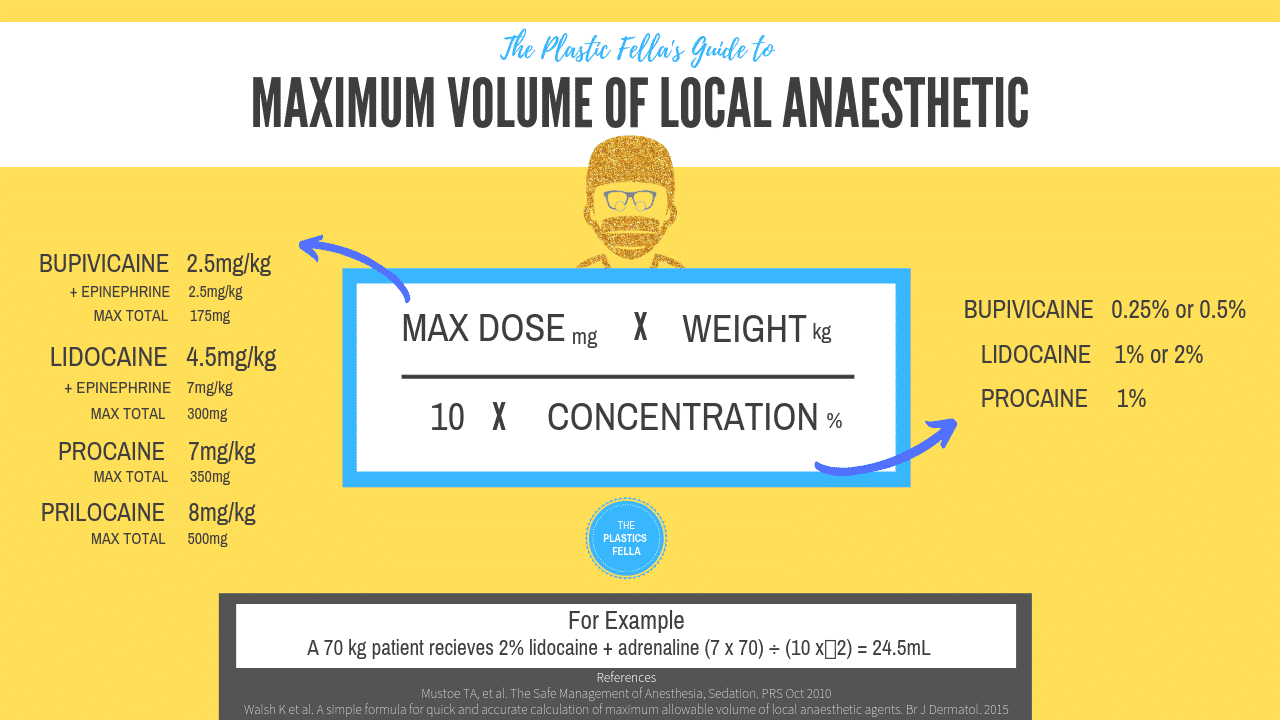Summary Card
Local Anaesthetic provides a temporary block to voltage-gated sodium channels. This prevents nerve impulse generation and conduction
Amides and esters are the two categories of local anaesthetics. They have a different duration of action and side-effect profiles.
Calculation of local anaesthetic volumes requires knowledge of the patient's body weight, max dose, and max concentration. Toxicity is rare but a potentially lethal complication that should be treated with a lipid rescue protocol.
Overview of Local Anaesthetic
Local anaesthetics are used in surgery to produce a reversible loss of sensation to the desired area by blocking the voltage-gated sodium channels required for nerve impulse generation and conduction.
Mechanism of Action
Key Point
Local anaesthetic blocks voltage-gated sodium channels to prevent the conduction and propagation of nerve impulses. This occurs quicker when the pKa is similar to the of human tissue and less effective in the presence of an infection.
Local anaesthetic blocks voltage-gated sodium channels to prevent the conduction and propagation of nerve impulses.
Some important pharmacokinetic points are related to pH, lipid solubility, and ionisation. For example:
- Local anaesthetics work when in an ionised state
- Act faster if acid dissociation constant (pKa) is similar to human tissue (pH 7.4)
- Act faster if high diffusion rather than through non-neural tissue
- Less effective in infections due to local hypoxia causing a raised tissue pH
- More effective when administered in an alkaline state (combined with sodium bicarbonate)
- Longer duration of action if more lipid-soluble (high affinity for axons)
Types of Local Anaesthesia
Key Point
The are two types of local anaesthetics - amides and esters. They have different mechanisms of action and metabolism pathways.
Amides and Esters
There are two types of local anaesthetics/anaesthesia. They are classified as:
- Esters: a type of para-aminobenzoic acid (PABA)–based anaesthesia
- Amide: a type of non-para-aminobenzoic acid (nPABA)–based anaesthesia
An important difference between these two groups is the manner in which they are metabolised
- Esters: metabolised in plasma by pseudocholinesterase to PABA (anaphylaxis)
- Amide: metabolised in the liver, less allergy risk.
Examples of these two types of local anaesthetics include:
- Esters: Benzocaine
- Amides: Bupivacaine
Both ester and amide local anaesthetics can be administered in different formulations (ointments, patches, and injections).

Local Anaesthestic Calculations
Key Point
There are 4 values in local anaesthetic calculations: maximum dose, maximum volume and concentration and patient's weight.
Principles of Calculations
There are 3 important numbers when it comes to a successful local anaesthetic calculation. It is important to note the different units of measurement - these need to be converted!
- Maximum dose (milligram/kilogram)
- Concentration (%)
- Patient's weight (kg)
These 3 variables are used to calculate the maximum recommended volume of local anaesthetic.
Step 1: Calculate Concentrations
There are two concentrations to be calculated - local anaesthetic and adrenaline (if used). They require a unit conversion.
Local Anaesthetic Concentration:
Concentration is expressed as a percentage (%) & max safe dose is mg/kg.
- Must convert % to mg/kg by multiplying the % by 10.
- For example, 1% lignocaine is 10mg/ml and bupivacaine 0.25% is 2.5mg/ml
Adrenaline Concentration:
Epinephrine concentrations are expressed as ratios & need to convert to mg/ml. This can be converted in 2 steps
- Convert the ratio as a %: 1 in 100 is 1% and 1 in 1000 in 0.1%.
- Multiply the % x 10 to get mg/ml.
- For example, 1:1000 epinephrine is 1mg/ml.
Step 2: Calculate Body Weight
The Devine formulation is the most commonly accepted calculation (most applicable for people at least 60 inches, or 5 feet, tall):
- IBW for men (kg) = 50 + 2.3 * (Height (in)-60)
- IBW for women (kg) = 45.5 + 2.3 * (Height (in)-60
Step 3: Determine Maximum Dose
This can be done by consulting your local hospital pharmacy guidelines. The table used at the beginning of this article is a guide only and does not replace your official documentation.
Step 4: Put Steps 1-3 in a formula

Local Anaesthetic Toxicity
Key Point
Local anaesthetic toxicity is a very rare side effect but it is potentially lethal. It is a progressive deterioration of the central nervous system and cardiovascular system. It is treated with an immediate resuscitation and lipid rescue protocol.
Signs and Symptoms
Local anaesthetic toxicity primarily affects the cardiovascular and central nervous systems.
- Head and Neck: Dizziness, Disorientation, Tinnitus, Perioral paresthesia
- Heart: Sinus bradycardia leading to sinus arrest, v. fib with bupivacaine.
- CNS: Seizures, Coma
Treatment
Local anaesthetic toxicity should be treated with immediate first aid, consultation with senior colleagues and anaesthetics, and a lipid rescue protocol.
An example of this protocol is:
- Intralipid 20% bolus 1.5mL/kg
- Infusion at 0.25mL/kg/min.
Please consult your local guidelines for a hospital protocol.
References
- 1. Mustoe TA, Buck DW II, Lalonde DH. The Safe Management of Anesthesia, Sedation, and Pain in Plastic Surgery. Plastic and Reconstructive Surgery. October 2010:165e-176e. doi:10.1097/prs.0b013e3181ebe5e9
- 2. Williams D, Walker J. A nomogram for calculating the maximum dose of local anaesthetic. Anaesthesia. 2014;69(8):847-853. https://www.ncbi.nlm.nih.gov/pubmed/24820093.


